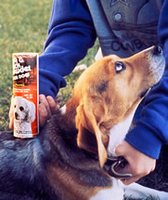Are Pit Bulls Dangerous To Children?

We all know that something comes to mind whenever "pit bull" is mentioned. More often than not, that something is negative. A large part of the reason why so many of us have negative thoughts about pit bulls despite never having had a bad experience due to one is because of the media. This is why many of us tend to think of pit bulls as particularly aggressive dogs which has actually fueled a drive in some parts of the country to ban the breed altogether. Despite a constant beating in the press, here are some facts about pit bulls:
* Pit bulls are the # 1 breed in the country but do not rank #1 on biting
* Pit bulls are classified as having an average temperament with breeds such as the golden retriever actually being known to be more aggressive
* Pit bull attacks have been on the decline since 1997
Another common misperception surrounding the pit bull is that the breed simply is not safe around children. Frankly speaking, no breed of dog or cat is completely safe around children if left unsupervised. But, while the press highlights rare occurrences of pit bull attacks upon children, the fact remains that the breed is completely safe around children if the following precautions are taken:
* All action between children and pit bull supervised
* All dog toys are first picked up
* Watch how child treats dog
* Teach dog basic obedience
* Do not put animal in situations it does not like
Supervise All Interaction
It is nothing short of simple common sense to supervise a dog and a young child playing together. In fact, the child should never be left alone with the dog period. This is especially true with younger children. Almost every single recorded attack involving a pit bull (or any breed for that matter) and a child happened while the adult was not present.
Pick Up All Pet Toys
A pit bull, like any dog, is going to be possessive of their toys. While the pet owner can get away with playing with the toys, a child may be perceived as potential competition. Plus, a dog toy is not going to be the most sanitary of things for a child to play with so its just a good idea all the way around to pick up the pit bull's toys before allowing a child into the area.
See How Child Interacts with Pit Bull
While a pit bull may have a better temperament than a golden retriever, it will have its limits just like any dog. It is not uncommon for children to be mean to dogs as they tend to punch and pull on everything they come into contact with during certain ages. The child must have a basic respect for dogs or else the pit bull is apt to nip at the child if it acts overly aggressive towards it. Children unfamiliar with dogs or having a fear of dogs should not under circumstances be left to play with a pit bull or any large breed for that matter.
Teach Pit Bull Basic Obedience
A pit bull must have a fundamental respect for the owner and its wishes if it is to be controlled properly. If the dog has not learned to respect your authority and do things like sit on command or lay down, then it should not be allowed around unfamiliar people—be they adult or child. A dog must be able to sit and allow itself to be pet by strangers if it is to be around children and any pit bull should be trained to lay down when they become too excited. Without these basic commands and a fundamental respect for the owner, a pit bull, like any large breed, would be a liability around children.
Do Not Make Dog Uncomfortable
There will just be some people that your pit bull may not like or be comfortable around. While some owners can be tempted to think that forcing the dog to interact with the stranger will eventually make things all right, it sets the stage for a bad situation. Pit bulls, like any dog breed, are largely instinctual. If a person makes them nervous for any reason, they are more likely to bite that person out of fear. It is best to keep nervous pit bulls in their own space rather than force them to interact with people that they do not like for some reason.
If these simple rules are adhered to, a pit bull can be perfectly safe around children. Being there to supervise the interaction really is the most important thing to remember. You should be able to tell if your dog is getting upset and be there to remove him or her from the situation when that happens. But remember—just as the dog needs to be trained in simple obedience, the children must be taught to have respect for the animals as well if the two are to ever get along and play safely together.
About The Author
David Black is a pit bull enthusiast and author of Professional Pit Bull Secrets. Pit Bull Secrets is one of the largest online pit bull communities in the world. http://www.pitbull-secrets.com.
* Pit bulls are the # 1 breed in the country but do not rank #1 on biting
* Pit bulls are classified as having an average temperament with breeds such as the golden retriever actually being known to be more aggressive
* Pit bull attacks have been on the decline since 1997
Another common misperception surrounding the pit bull is that the breed simply is not safe around children. Frankly speaking, no breed of dog or cat is completely safe around children if left unsupervised. But, while the press highlights rare occurrences of pit bull attacks upon children, the fact remains that the breed is completely safe around children if the following precautions are taken:
* All action between children and pit bull supervised
* All dog toys are first picked up
* Watch how child treats dog
* Teach dog basic obedience
* Do not put animal in situations it does not like
Supervise All Interaction
It is nothing short of simple common sense to supervise a dog and a young child playing together. In fact, the child should never be left alone with the dog period. This is especially true with younger children. Almost every single recorded attack involving a pit bull (or any breed for that matter) and a child happened while the adult was not present.
Pick Up All Pet Toys
A pit bull, like any dog, is going to be possessive of their toys. While the pet owner can get away with playing with the toys, a child may be perceived as potential competition. Plus, a dog toy is not going to be the most sanitary of things for a child to play with so its just a good idea all the way around to pick up the pit bull's toys before allowing a child into the area.
See How Child Interacts with Pit Bull
While a pit bull may have a better temperament than a golden retriever, it will have its limits just like any dog. It is not uncommon for children to be mean to dogs as they tend to punch and pull on everything they come into contact with during certain ages. The child must have a basic respect for dogs or else the pit bull is apt to nip at the child if it acts overly aggressive towards it. Children unfamiliar with dogs or having a fear of dogs should not under circumstances be left to play with a pit bull or any large breed for that matter.
Teach Pit Bull Basic Obedience
A pit bull must have a fundamental respect for the owner and its wishes if it is to be controlled properly. If the dog has not learned to respect your authority and do things like sit on command or lay down, then it should not be allowed around unfamiliar people—be they adult or child. A dog must be able to sit and allow itself to be pet by strangers if it is to be around children and any pit bull should be trained to lay down when they become too excited. Without these basic commands and a fundamental respect for the owner, a pit bull, like any large breed, would be a liability around children.
Do Not Make Dog Uncomfortable
There will just be some people that your pit bull may not like or be comfortable around. While some owners can be tempted to think that forcing the dog to interact with the stranger will eventually make things all right, it sets the stage for a bad situation. Pit bulls, like any dog breed, are largely instinctual. If a person makes them nervous for any reason, they are more likely to bite that person out of fear. It is best to keep nervous pit bulls in their own space rather than force them to interact with people that they do not like for some reason.
If these simple rules are adhered to, a pit bull can be perfectly safe around children. Being there to supervise the interaction really is the most important thing to remember. You should be able to tell if your dog is getting upset and be there to remove him or her from the situation when that happens. But remember—just as the dog needs to be trained in simple obedience, the children must be taught to have respect for the animals as well if the two are to ever get along and play safely together.
About The Author
David Black is a pit bull enthusiast and author of Professional Pit Bull Secrets. Pit Bull Secrets is one of the largest online pit bull communities in the world. http://www.pitbull-secrets.com.
Labels: pit bull











